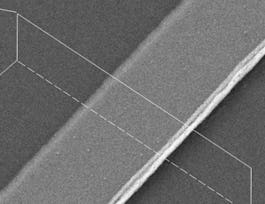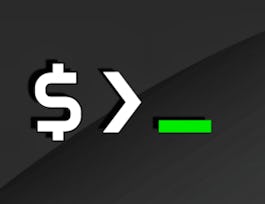Le cours présente les trois principales méthodes spectroscopiques utilisées par les chimistes et les biochimistes pour analyser la structure moléculaire et électronique des atomes et des molécules. Il s'agit des spectroscopies UV/Visible, infrarouge (IR) et de résonance magnétique nucléaire (RMN). Le contenu est présenté à l'aide de courtes présentations ciblées et interactives accompagnées de quiz formatifs pour vérifier la compréhension des concepts clés présentés. De nombreux exercices sont fournis pour faciliter la maîtrise de chaque sujet. Un laboratoire spectroscopique virtuel unique est mis à la disposition des étudiants pour leur permettre de mesurer et d'analyser des spectres en ligne. L'évaluation se fait par le biais de quiz sommatifs réalisés pendant la durée du cours.



Introduction à la spectroscopie moléculaire

Instructeur : Patrick J O'Malley, D.Sc
63 389 déjà inscrits
Inclus avec 
(2,525 avis)
Détails à connaître

Ajouter à votre profil LinkedIn
7 devoirs
Découvrez comment les employés des entreprises prestigieuses maîtrisent des compétences recherchées


Obtenez un certificat professionnel
Ajoutez cette qualification à votre profil LinkedIn ou à votre CV
Partagez-le sur les réseaux sociaux et dans votre évaluation de performance

Il y a 4 modules dans ce cours
Dans cette première semaine, nous présentons le spectre électromagnétique et l'origine des transitions donnant lieu aux spectres ultraviolet et visible (UV/Vis). Vous apprendrez que les transitions électroniques sont provoquées par l'absorption de radiations dans la région UV/Vis du spectre électromagnétique. La raison de la longueur d'onde et de l'intensité des bandes sera décrite et l'origine de la couleur de certains composés sera discutée. On vous montrera également comment la spectroscopie UV/Vis est effectuée et vous serez en mesure d'exécuter et d'analyser vos propres spectres. L'activité finale de ce module vous donne un lien pour voir comment obtenir un spectre UV/Visible en laboratoire. Bonne chance, essayez de participer aux forums de discussion pour améliorer votre apprentissage et n'oubliez pas de répondre au questionnaire de laboratoire de fin de semaine qui contribue à votre note finale.
Inclus
10 vidéos7 lectures2 devoirs
Dans ce module, nous présentons la théorie qui sous-tend la spectroscopie infrarouge (IR) et montrons des exemples d'analyses utilisant cette technique. Les transitions entre les niveaux d'énergie vibratoire des molécules se produisent dans la région infrarouge du spectre électromagnétique. Nous commençons par la théorie qui sous-tend la vibration en utilisant le modèle simple de l'oscillateur harmonique. L'analyse de molécules plus complexes est introduite en utilisant les fréquences de groupe et le nombre de modes vibrationnels. On vous montrera également comment obtenir un spectre infrarouge et vous aurez l'occasion d'exécuter votre propre spectre. À la fin de ce module, vous trouverez un lien qui vous permettra de voir comment obtenir un spectre infrarouge en laboratoire. N'oubliez pas de répondre à l'interrogation de fin de semaine en laboratoire qui contribue à votre note finale pour ce cours.
Inclus
6 vidéos4 lectures2 devoirs
Cette semaine, nous nous concentrons sur la spectroscopie par résonance magnétique nucléaire (RMN). Dans ce cas, un champ magnétique est utilisé pour créer des niveaux d'énergie pour les noyaux magnétiques présents dans une molécule. La transition entre ces niveaux d'énergie se produit dans la région radiofréquence du spectre électromagnétique. La position des bandes dans le spectre observé dépend du blindage des noyaux par la structure électronique locale, ce qui donne lieu à un paramètre connu sous le nom de déplacement chimique. Les bandes présentent également une structure fine due au couplage spin-spin avec les noyaux voisins. Des exemples d'analyse de spectres RMN pour la détermination de structures seront donnés. L'activité finale de ce module vous donne un lien pour voir comment obtenir un spectre RMN en laboratoire. N'oubliez pas de répondre à ce quiz de laboratoire de fin de semaine qui contribue à votre note finale.
Inclus
9 vidéos4 lectures2 devoirs
Inclus
1 devoir
Instructeur

Offert par
Recommandé si vous êtes intéressé(e) par Chimie

University of Cape Town

University of Colorado Boulder

Dartmouth College
Pour quelles raisons les étudiants sur Coursera nous choisissent-ils pour leur carrière ?




Avis des étudiants
2 525 avis
- 5 stars
76,62 %
- 4 stars
18,71 %
- 3 stars
3,59 %
- 2 stars
0,75 %
- 1 star
0,31 %
Affichage de 3 sur 2525
Révisé le 25 oct. 2017
Some of the questions had wrong answers in the system and hence the actual marks shown is not reflective of the exam. Please see to it that the system has correct answers.
Révisé le 12 avr. 2022
Practical and worthwhile. Supplementary short videos that give a brief overview of each technique was helpful for me to get a handle of some of the theoretical concepts.
Révisé le 14 oct. 2020
This course helped me to further understand the principle behinds the 3 main spectroscopic techniques: UV/VIS, IR and NMR which is very beneficial for my future career working in a lab environment.

Ouvrez de nouvelles portes avec Coursera Plus
Accès illimité à 10,000+ cours de niveau international, projets pratiques et programmes de certification prêts à l'emploi - tous inclus dans votre abonnement.
Faites progresser votre carrière avec un diplôme en ligne
Obtenez un diplôme auprès d’universités de renommée mondiale - 100 % en ligne
Rejoignez plus de 3 400 entreprises mondiales qui ont choisi Coursera pour les affaires
Améliorez les compétences de vos employés pour exceller dans l’économie numérique
Foire Aux Questions
L'accès aux cours et aux devoirs dépend de votre type d'inscription. Si vous suivez un cours en mode audit, vous pourrez consulter gratuitement la plupart des supports de cours. Pour accéder aux devoirs notés et obtenir un certificat, vous devrez acheter l'expérience de certificat, pendant ou après votre audit. Si vous ne voyez pas l'option d'audit :
Il se peut que le cours ne propose pas d'option d'audit. Vous pouvez essayer un essai gratuit ou demander une aide financière.
Le cours peut proposer l'option "Cours complet, pas de certificat" à la place. Cette option vous permet de consulter tous les supports de cours, de soumettre les évaluations requises et d'obtenir une note finale. Cela signifie également que vous ne pourrez pas acheter un certificat d'expérience.
Lorsque vous achetez un certificat, vous avez accès à tous les supports de cours, y compris les devoirs notés. Une fois le cours terminé, votre certificat électronique sera ajouté à votre page de réalisations. Vous pourrez alors l'imprimer ou l'ajouter à votre profil LinkedIn. Si vous souhaitez uniquement lire et visualiser le contenu du cours, vous pouvez l'auditer gratuitement.
Vous pouvez prétendre à un remboursement intégral jusqu'à deux semaines après la date de votre paiement ou (pour les cours qui viennent d'être lancés) jusqu'à deux semaines après le début de la première session du cours, la date la plus tardive étant retenue. Vous ne pouvez pas obtenir de remboursement une fois que vous avez obtenu un certificat de cours, même si vous terminez le cours pendant la période de remboursement de deux semaines. Consultez notre politique de remboursement complète.


